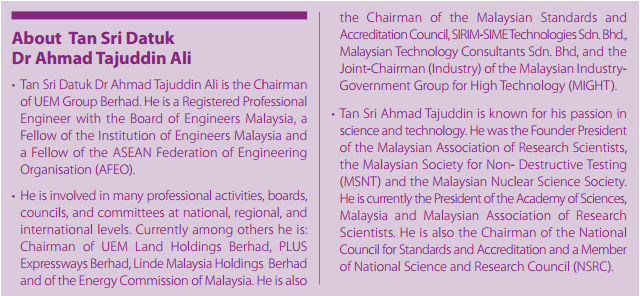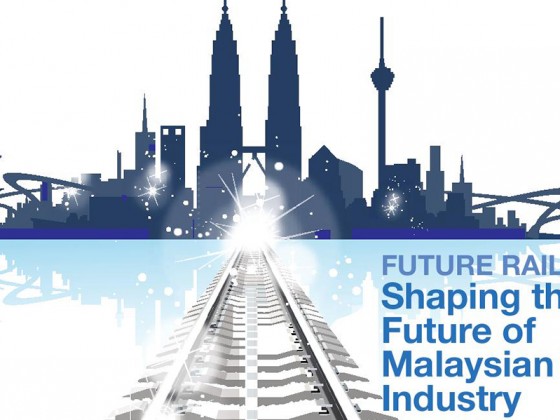In person with Tan Sri Datuk Dr. Ahmad Tajuddin Ali
Foresight is not just about tomorrow, but years to come. We have to look at 20-50 years from today – what trends are going to happen and to make necessary adjustments today.
Foresight is not just about tomorrow, but years to come. We have to look at 20-50 years from today – what trends are going to happen and to make necessary adjustments today. The future is bleak … and this is not the ‘feel good’ time because my view of the future – 20 to 50 year’s time – is indeed bleak for this country. I have my own reasons, but I really hope that when the time comes, I’m proven wrong.
There are many factors and indicators that show we are not heading in the right direction. Let’s start with the global challenges. There are big issues being debated in all international forums, for instance Rio +20. During Rio +20, The International Institute for Applied System Analysis (IIASA) presented the global energy assessment which shows that the world is facing challenges, namely in energy, climate change, food security, food production, poverty and equity. All these challenges are interrelated and each one feeds the other.
We certainly cannot extract ourselves from being in that predicament as part of the global community. For example, food crisis, energy crisis and poverty issues in Africa will become even more critical as we go forward. Continuous consumption of energy due to growing population is impacting the food prices and distribution.
Energy prices will continue to escalate and Malaysia is currently importing much of our energy. Although we produce palm oil, the plantation will be competing with the growing population for land. Soon, those agricultural lands will be converted into housing and industrial area. At the same time we are facing the global demand and pressures to preserve our rainforest and greenery, hence, preventing further conversion of our virgin jungles into palm oil plantations.
I’m quoting a few known challenges in terms of rising population, increase cost of food production, distribution, and storage – the whole line of food security. Water scarcity is another global problem that is being faced in Malaysia too. If we look forward to 20 to 30 years from now, the water problem will be acute. All these issues – food shortages, energy crisis, water scarcity, etc. – will have an impact on us and hamper our growth. However, we are very lucky to be where we are today. We have exploited and make good use of our existing resources – labour, land and technology so far. But we know that it is not adequate. For instance, the labour cost in Malaysia is not as competitive as it is in China. Land scarcity and increasing land prices limit our ability to offer foreign businesses to open their plants here. When Malaysia aims for Knowledge Economy and moves towards higher income society there are also hindrances such as inadequate investment in R&D, small GDP etc.
In the context of global competition, Malaysia is, at the moment, too dependent on imported or foreign technologies and the people. This includes experts and their expertise, ownership of patent right, etc. – as the basis of our manufacturing and production. We need to extract more value from the resources that we have today. In palm oil, for instance, we need more than what we already have now. By going downstream we can produce higher quality products range across the value chain; from the raw materials to the end products. This can be done with the aid of our own scientists in our own laboratories, by generating new sources of intellectual property rights on products and processes. We can boost our production, locally or abroad, but hold the IP rights. We should try to reverse the current scenario where laboratories abroad use our raw materials for their productions but hold the IP rights, and sell back the end products to us at higher prices.
The greatest danger to humanity is complacency. As for the theory of abundance, I would prefer to look from the opposite end. When we say there are pockets of abundance, there are also pockets of poverty. When I see towards 20 to 30 years in the future, I see regions in the world that will be very unstable due to poverty, hunger, overpopulation, etc. It has happened – in Somalia and Sudan. Inequity is the main cause of the instability, and the impact could be cross-borders. For example, the needs – rather than the demand – for water. Water is one example on competing demand for resources. Water source, may come from an upstream in one country and flow to a downstream in another country with the latter depending very much on what is coming from the former. There could be diversion of water resources in order to optimise the use by the upstream country, thus depriving the supply to the downstream country. This will cause the supply-demand conflict.
Our education system aims to have 60:40 ratio of science to art students. Sadly, today we only have less than 30% students in the science stream. If this trend continues, future Malaysians will be pure consumers of technology. Only a small percentage of our population will engage in S&T, especially R&D thus, decreasing the chances of Malaysia to be a producer of technology that can contribute more to wealth.
Greater challenges are faced by teachers today compared to yesteryears. Continuous use of traditional teaching methods are no longer conducive as students are now sometimes ahead of their teachers and become less interested to be in school. Unless the interest in technology amongst students is inculcated, nourished and developed, future Malaysians will be technology consumers, not producers. Only through strong foundation of science and mathematics in our education system, are we able to groom future researchers, scientist and innovators.
One of the things that worry me is that we failed at regeneration of talents in the management of STI and R&D. There are several institutions that fail to leap forward from the foundations that were set by earlier founders. Somehow, these foundations have gone into some sort of oblivion.
Some of the institutions and organizations that were vibrant before are not moving forward because they are trapped in their cocoon. They are not creative and innovative to face current changes and challenges.
Staying in the same trajectory is fine, but if we stay at that level while everybody else is moving forward, we are actually moving backwards. The pessimism in me is for a good reason, and I would like to help. Through NSRC, for instance, we intend to reorganise things in order to redirect the ships that are already afloat to face stormy waters ahead.
There are so many other things that we can do to create and generate interest of the younger generation in S&T. Real innovation is the one that will really create value and has to be based on S&T, knowledge and strong foundation in science, engineering and mathematics.
At this point I am pessimistic. But I hope my pessimism will lead to actions being taken, actions that will prove 30 -50 years from now – although I may not be around to see it – that I’m wrong… then I will be happy.










